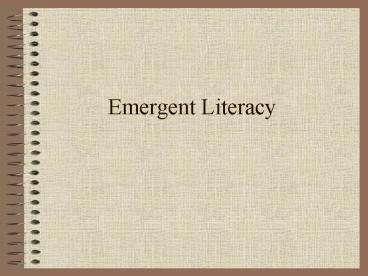Emergent Literacy - PowerPoint PPT Presentation
1 / 19
Title:
Emergent Literacy
Description:
Big Books & Predictable Books (repetitive, rhythm and rhyme, sequential patterns) ... Identify letter names, upper and lower case, capital ... Fives and Sixes ... – PowerPoint PPT presentation
Number of Views:70
Avg rating:3.0/5.0
Title: Emergent Literacy
1
Emergent Literacy
2
Supporting Emergent Readers and Writers
- Print-Rich Environment
- Concept of a word
- Environmental Print
- The Morning Message
- Literacy Play Centers
- Big Books Predictable Books (repetitive, rhythm
and rhyme, sequential patterns) - Creative Dramatics
- Shared-Book Experiences
- Reading Buddies
- Traveling Bags of Books
3
Concepts of Print
- Book-orientation concepts
- how to hold books and turn pages
- Directionality concepts
- print is read from left to right and top to
bottom - Letter and word concepts
- Identify letter names, upper and lower case,
capital letter begins a sentence, space marks and
boundaries between words and sentences
4
Concepts about the Alphabet
- The letters name
- Formation of letter
- Visual Discrimination
- Direction of the letter
- Use of the letter in common words
- Sound in isolation
- Letter in combinations
- Letter in context
5
Shared Reading
- Read aloud
- Appropriate for interest level
- Too difficult for independent reading
- Big Books/Charts
- Multiple readings of books
6
Emergent Writing
- Writing is social
- Children observe parents and older siblings
writing - Begin to mimic what they observe
- Children confer with one another
- They talk to themselves
- Share their writing
7
Stages of Writing Development
- Infants
- Grasping and holding writing utensils
- Making Marks
- Toddlers
- Scribbles
- Repetitive angular Marks
- Use drawing and writing to describe scribbles
8
- Threes and Fours
- Begin to distinguish between writing and drawing
- Explore writing forms and become interested in
conventional letters - Begin to understand the functions of print
- Incorporate writing in to their play
9
- Fives and Sixes
- Children begin to understand the relationship
between sounds and letters (phonemic awareness) - Know a few letter sound combinations (
- Combine writing and drawing to create a richer
message
10
Guidelines
- Accept childrens forms of writingdoes not have
to look like adult writing - Allow children to share
- Let them write their names
- Use writing to communicate
- Make writing materials available
- Provide time for children to write
11
Invented Spellings
- An attempt to spell a word whose spelling is not
already known, based on a writers knowledge of
the spelling system and how it works (Harris
Hodges, 1995, p.123) - Children use their knowledge of letter-sound
relationships - Teachers observations of childrens invented
spellings give them insight into their phonemic
awareness
12
Purposeful Writing
- To communicate meaning
- Pen-pals
- Individual mailboxes
- Centers (post office, office center, restaurant
center, grocery center) - Journal writing (children can write or draw)
- Writing center- variety of paper and writing
utensils
13
The value of writing activities
- Students can not remain passive learners when
engaged in writing activities related to content - Writing activities demand participation by every
student, not just those who volunteer - Writing activities quickly demonstrate whether
students understand a topic
14
Some Guidelines
- Writing in the classroom should be frequent and
varied - Every writing does not have to be graded
- Writing activities can be short and
non-threatening - Writing activities should have a real and
immediate audience (the audience should be more
than simply the teacher) - Publish and Celebrate your students writings
- Writing does not always have to be an essay or a
summary
15
(No Transcript)
16
Writing Assignments
- Effective writing assignments are essential
- (e.g., bad assignments yield bad writing)
- Set purpose
- Topic or Possible Topics related to Content
- Audience (who will read or hear writing)
- Possible modes or formats (e.g., essay, letter,
poem, etc.)
17
The Writing Process
- Pre-writing
- Drafting
- Revising
- Editing
- Sharing and Publishing
18
Handwriting
- Many teachers no longer stress consistent
penmanship for every student. - Traditionally handwriting was considered an art
form - Modern handwriting does stress legibilitywell-for
med letters, consistent slant, and proper spacing
of words. - Modern handwriting considered a tool for
communication - Different teachers use different styles
19
Instruction
- Involves
- Readiness activities
- Correct sitting posture
- Correct letter formation
- Proper spacing
- Alignment
- Uniform slanting of letters










![❤[PDF]⚡ Reflective Teaching, Effective Learning: Instructional Literacy for Library PowerPoint PPT Presentation](https://s3.amazonaws.com/images.powershow.com/10050408.th0.jpg?_=202406071110)




















